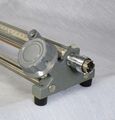874-LBA: Difference between revisions
No edit summary |
(→Links) |
||
| (6 intermediate revisions by one other user not shown) | |||
| Line 1: | Line 1: | ||
{{GR Product | {{GR Product | ||
|model=874-LBA | |model=874-LBA | ||
|codes=COAXRUNNER | |||
|class=coaxial elements | |class=coaxial elements | ||
|summary=Slotted Line | |summary=Slotted Line | ||
|image=GR 874-LBA Close-up.jpg | |image=GR 874-LBA Close-up.jpg | ||
|caption=General Radio 874-LBA Slotted Line | |caption=General Radio 874-LBA Slotted Line | ||
|series=874 | |series=GR-874 | ||
|introduced=1956 | |introduced=1956 | ||
|discontinued=1965 | |discontinued=1965 | ||
|designers= | |designers= | ||
|manuals= | |manuals= | ||
* [[Media:GR 874-LLA_LLB Slotted Line 0874-0215-I 04_1966.pdf|General Radio 874-LBA Slotted Line Manual 0874-0215-I 1966]] | * [[Media:GR 874-LLA_LLB Slotted Line 0874-0215-I 04_1966.pdf|General Radio 874-LBA/874-LBB Slotted Line Manual 0874-0215-I 1966]] | ||
{{Catalog History}} | {{Catalog History}} | ||
}} | }} | ||
The {{Title|General Radio 874-LBA Slotted Line}} was introduced in {{Catalog O}} and remained available through {{Catalog S}}. Its function is to observe the electric field along the inside of a coaxial transmission line using a carriage-mounted probe moving along the line. | The {{Title|General Radio 874-LBA Slotted Line}} was introduced in {{Catalog O}} and remained available through {{Catalog S}}. Its function is to observe the electric field along the inside of a coaxial transmission line using a carriage-mounted probe moving along the line. | ||
By observing minima and maxima of a standing-wave pattern, the characteristics of a circuit connected to the load side of the line can be determined. Applications include | By observing minima and maxima of a standing-wave pattern, parameters like frequency, standing-wave ratio, or impedance can be measured, and thereby the characteristics of a circuit connected to the load side of the line can be determined. Applications include analysis of antennas, components, coaxial elements, and networks. | ||
The 874-LBA is an update of the [[874-LB]], featuring improved accuracy and carriage construction. The redesigned carriage is controlled by a nylon cord and a series of pulleys to remove its drive control to a fixed position at the load end. | The 874-LBA is an update of the [[874-LB]], featuring improved accuracy and carriage construction. The redesigned carriage is controlled by a nylon cord forming a complete loop, and a series of pulleys to remove its drive control to a fixed position at the load end. This reduces changes in probe coupling caused by changing forces on the carriage. An optional [[874-LV|874-LV Micrometer Vernier]] can be attached for high-resolution measurements. | ||
The 874-LBA was supplied with a protective wooden case, a spare nylon cable, and a crystal detector. | The 874-LBA was supplied with a protective wooden case, a spare nylon cable, and a crystal detector. | ||
| Line 25: | Line 26: | ||
* '''Characteristic Impedance:''' 50 Ω, ±0.5% | * '''Characteristic Impedance:''' 50 Ω, ±0.5% | ||
* '''Scale Accuracy:''' ±(0.1 mm +0.05%) | * '''Scale Accuracy:''' ±(0.1 mm +0.05%) | ||
* '''Frequency Range:''' 300 MHz to 5 GHz | * '''Frequency Range:''' 300 MHz to 5 GHz; for measurements below 300 MHz, add [[874-L30]] air line sections | ||
* '''Length:''' 50 cm probe travel (λ/2 @ 300 MHz, λ/4 @ 150 MHz) | |||
* '''Constancy of Probe Penetration:''' ±1½% | * '''Constancy of Probe Penetration:''' ±1½% | ||
* '''Residual SWR:''' 1.025 @ 1 GHz, 1.07 @ 4 GHz | |||
==Links== | ==Links== | ||
| Line 32: | Line 35: | ||
* [[Media:GR Exp 874-LBA 12_1954.pdf|Experimenter December 1954 describing Type 874-LBA]] | * [[Media:GR Exp 874-LBA 12_1954.pdf|Experimenter December 1954 describing Type 874-LBA]] | ||
* [[Media:1N Series Microwave Diode Data Sheet.pdf|1N23B Microwave Diode Data]] | * [[Media:1N Series Microwave Diode Data Sheet.pdf|1N23B Microwave Diode Data]] | ||
* [[Media:Handbook of Coaxial Microwave Measurements.pdf|Handbook of Coaxial Microwave Measurements]] | |||
* [https://www.youtube.com/watch?v=DovunOxlY1k&t=668s AT&T Archives Wave Machine Tutorial] @ YouTube | * [https://www.youtube.com/watch?v=DovunOxlY1k&t=668s AT&T Archives Wave Machine Tutorial] @ YouTube | ||
* Predecessor: [[874-LB]] | |||
* Successor: [[874-LBB]] (8.5 GHz) | |||
==Photos== | ==Photos== | ||
Latest revision as of 02:12, 30 May 2024
The General Radio 874-LBA Slotted Line was introduced in Catalog O (1956) and remained available through Catalog S (1965). Its function is to observe the electric field along the inside of a coaxial transmission line using a carriage-mounted probe moving along the line.
By observing minima and maxima of a standing-wave pattern, parameters like frequency, standing-wave ratio, or impedance can be measured, and thereby the characteristics of a circuit connected to the load side of the line can be determined. Applications include analysis of antennas, components, coaxial elements, and networks.
The 874-LBA is an update of the 874-LB, featuring improved accuracy and carriage construction. The redesigned carriage is controlled by a nylon cord forming a complete loop, and a series of pulleys to remove its drive control to a fixed position at the load end. This reduces changes in probe coupling caused by changing forces on the carriage. An optional 874-LV Micrometer Vernier can be attached for high-resolution measurements.
The 874-LBA was supplied with a protective wooden case, a spare nylon cable, and a crystal detector.
Specifications
- Characteristic Impedance: 50 Ω, ±0.5%
- Scale Accuracy: ±(0.1 mm +0.05%)
- Frequency Range: 300 MHz to 5 GHz; for measurements below 300 MHz, add 874-L30 air line sections
- Length: 50 cm probe travel (λ/2 @ 300 MHz, λ/4 @ 150 MHz)
- Constancy of Probe Penetration: ±1½%
- Residual SWR: 1.025 @ 1 GHz, 1.07 @ 4 GHz
Links
- Experimenter December 1954 describing Type 874-LBA
- 1N23B Microwave Diode Data
- Handbook of Coaxial Microwave Measurements
- AT&T Archives Wave Machine Tutorial @ YouTube
- Predecessor: 874-LB
- Successor: 874-LBB (8.5 GHz)











